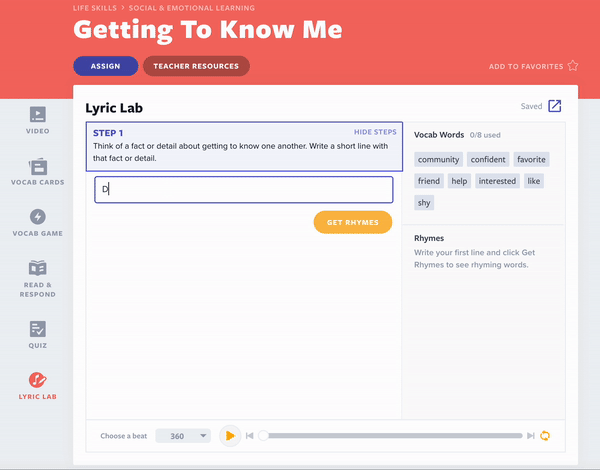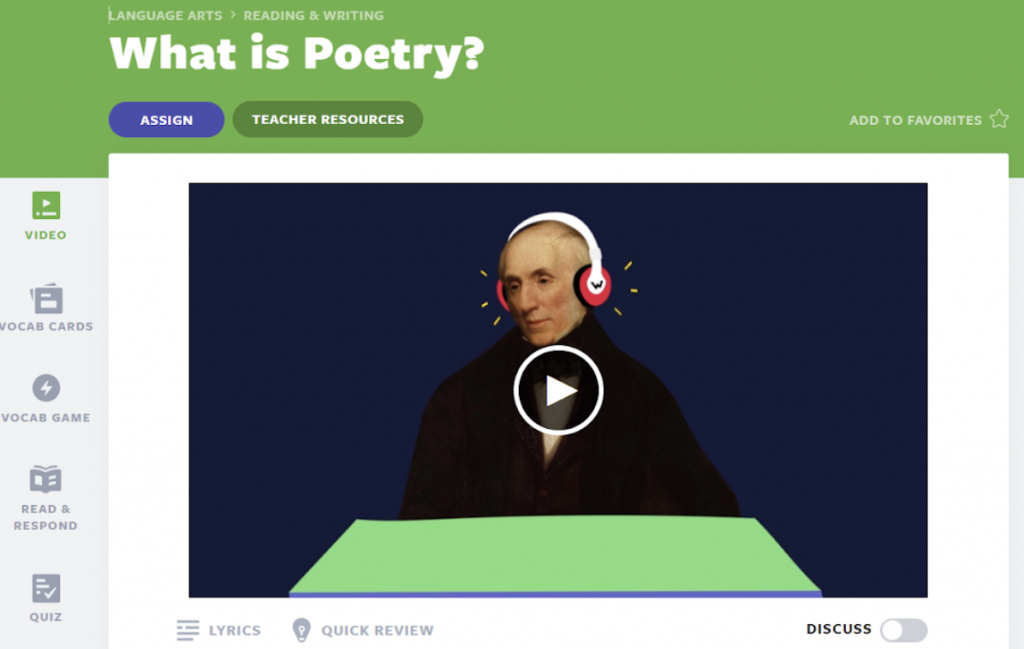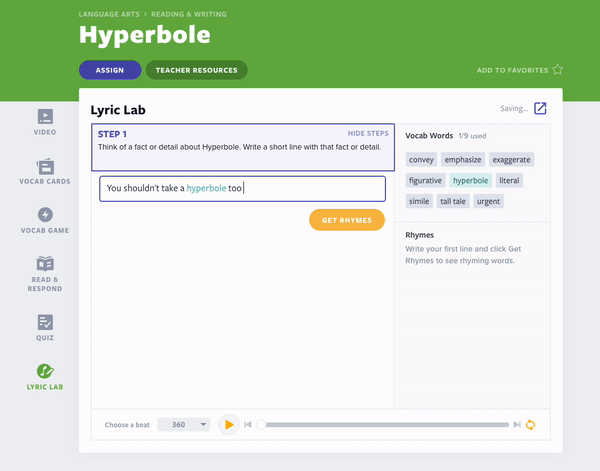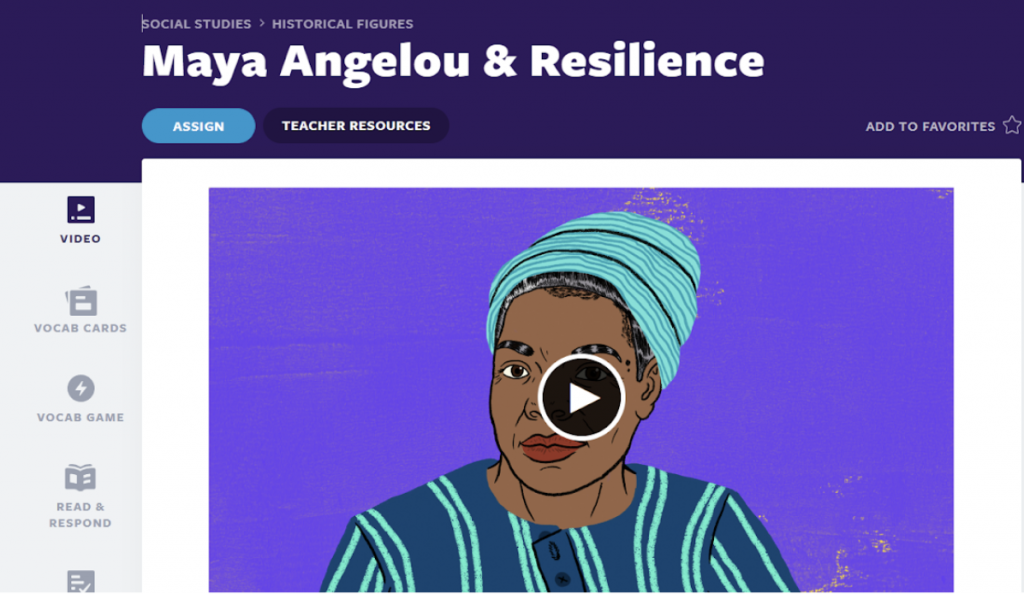Not only does April bring showers, but also Poetry Month activities. Poetry is a genre that’s a jack of all trades. The friend who fits in at any lunch table. Its wonders never cease to amaze. Need to teach how fluency matters? Poetry’s here for you – helping readers practice tone, pitch, and volume. Want to help with phonemic awareness? Poems have rhyme, alliteration, syllable patterns, and assonance to aid young students just by listening. Wish to expand the writing of your students? Poetry pushes writers to elevate their style, asking for figurative language, expansive vocabulary, and imagery.
Flocabulary’s K-12 standard-aligned video-based lessons and activities leverage the power of hip-hop, storytelling, and emotional connections to cultivate literacy across the curriculum. Flocabulary is proven to strengthen a student’s understanding and highly engage them, ultimately leading to improved learner outcomes. Whether you’re teaching a poetry unit in your classroom or celebrating Poetry Month, these Flocabulary activities will keep students engaged in their learning.
New to Flocabulary? Sign up for an account to access these activities and lessons.
Why is it important to teach poetry?
If nothing else, poetry should be taught to students because it reflects the world around us. It has a cultural impact. From epic Greek poems to the Harlem Renaissance, poetry provides glimpses into feelings and ideas felt at the time by real people who lived it. Because of poetry’s importance, using words to sketch our lives and connect us all, what better resource for teachers to use than that technology? Technology grants all learners access to poetry. Whether through a variety of mediums such as videos, pictures, or audio recordings to text accessibility features that read poems to students who may not be able to read otherwise. Technology helps make teaching poems more understandable.
Poetry Month activities for your classroom
1. Start off by teaching the basic concepts
We often perceive poetry as lofty and complicated. However, Flocabulary’s videos and lesson library makes teaching poems relatable to students. Our videos are engaging and even mimic slam poetry. Not only that, we have videos to help new poets understand the craft and structure of poems.
Explore poetry activities perfect for teaching elementary, middle, and high school. There are lesson plans, handouts, vocabulary games and cards, quizzes, and a rhyme generator, such as:
2. Leverage vocabulary’s role in poetry
Writing poetry is all about purposeful word choice and surfaces rich discussions on vocabulary by readers everywhere. Through learning about figurative language, all students can practice using academic vocabulary in less traditional concepts to showcase complex meanings.
Academic vocabulary is a leading indicator of student comprehension. Students need as many as 17 exposures to a word in a range of different contexts for that word to move into their long-term memory (Marzano). Hip-hop has 2-3 times the number of words per song compared to other genres, making it the perfect format to teach academic vocabulary.
Flocabulary strategically uses hip-hop as the foundational medium to teach vocabulary, provide the necessary in-context word exposure, and develop a deep understanding of academic terminology.
Start discussions about poetry by learning the vocabulary used in the structure of poems with the figurative language lesson. Students watch the video to introduce the vocabulary and follow it with supporting activities that deepen their understanding of the terms along the way.
Watch the video below to see the power of Flocabulary videos!
3. Have students write poems using Lyric Lab
The Lyric Lab activity gives students the opportunity to create their own rhymes using the academic vocabulary covered in the accompanied Flocabulary lesson. You can assign a Lyric Lab for students to complete, or they can independently create their own rhymes simply by logging into their student account and selecting Lyric Lab for any lesson.
With Lyric Lab, students are developing the deepest level of understanding of vocabulary terms in a lesson. Students use the vocabulary terms that surfaced in a lesson to write about that topic. Hip-hop is a great mnemonic strategy to help students reflect and showcase their own personal understanding that they can use throughout the whole lesson unit.
Students can use these poetry month activities to write poems about any topic across the K-12 curriculum. Although Lyric Lab can be used to write a rap about a topic, students can also take those same lessons and tools to create poetry.
How to use Lyric Lab
Here’s how you can use Lyric Lab’s built-in rhyme generator to help students find rhymes as they write:
1. Flocabulary’s video and Lyric Lab activity are perfect for an introductory lesson. Choose a lesson from the library. Let’s use the Hyperbole lesson as an example.
2. Students watch the lesson video, which includes engaging visuals and catchy rhymes about this poetic concept, individually or as a class.
3. Students can then click on the Lyric Lab section of the Hyperbole lesson.
4. Lyric Lab will have a list of relevant vocabulary used in the video for students to use to create their own rhymes.
5. As they type their rhymes, Lyric Lab will generate words they can use to rhyme in their next line.
6. Once their lyrics are complete, students can select one of Flocabulary’s beats to accompany their song.
7. Have students submit a video or voice recording of their final song, or have the class perform their masterpieces to each other!
After students create their own lyrics explaining what a hyperbole is, it can guide them to write their own poems with hyperbole or even read poems where they have to find examples of hyperbole. Some great famous poem examples to include in your poetry activities are “I Wandered Lonely as a Cloud” by William Wordsworth and “My Heart Beats for You” by Kelly Roper.
4. Meet common core standards by performing
Speaking and listening standards appear across many grade levels, with students being asked to perform speeches orally and understand and practice active listening skills. While writing poems can help support vocabulary acquisition and deep understanding, performing it will help teachers meet some speaking and listening standards as well.
Poetry’s short nature also helps students who are easily overwhelmed with lengthy writing assignments or those who are nervous about public speaking. When students share poetry aloud, they can experience figurative language and all its parts in new and interesting ways.
5. Host a poetry slam

Why not let students share their writing by hosting class slam poetry sessions? Poems are meant to be read aloud. It evokes feelings, which can be felt when spoken. Poetry slams are beneficial not only with writing but also with reading fluency.
Lyric Lab can be tied to any lesson. It’s a helpful introduction to help students fully grasp poetry concepts, styles, and vocabulary. Students make it their own instead of teachers lecturing definitions they may not understand. This ensures they understand and showcase what they’ve learned.
Flocabulary’s videos teach concepts and what slam poetry sounds like. It’s meant to be read aloud. Pick a Flocabulary video for students to emulate a poetry slam to inspire and encourage them.
6. Pick a poet and analyze their work
Pick a Poet is an activity among our list of poetry month activities that give students the freedom to choose a poet to learn about and emulate his or her poetic style. Assign students a famous poet or style of poetry to mimic, or even better, let students choose what interests them.
Flocabulary has a library full of videos about poets, such as:
Students can learn about the poet’s life, style, and impact on poetry. Or learn about that particular poetic style. They then create their own poems and present information about that poet to the class.
7. Use the power of music
Music and poetry share a timeless relationship. In the past, poems were often sung, so why not teach using music? For teaching high school, you can create lessons in Nearpod and Flocabulary demonstrating the close relationship between poems and music, adding digital poetry activities for students to complete along the way. Students pick lyrics from their favorite song or artist and analyze them through the lens of poetry. If students already studied different poetic styles, they can try to analyze what style of poetry that song would work in and why – evaluating rhythm, poetic devices, themes, etc.
Start using Flocabulary to teach poetry
Spring brings with it growth, and these poetry activities can be expanded and modified to fit in with any teacher’s lessons. April is the perfect month to teach the importance of poetry with enjoyable lessons that allow students creative freedom.
New to Flocabulary? Sign up for an account to access these activities and lessons.
- SEO Powered Content & PR Distribution. Get Amplified Today.
- Platoblockchain. Web3 Metaverse Intelligence. Knowledge Amplified. Access Here.
- Source: https://blog.flocabulary.com/how-to-use-flocabulary-for-poetry-month/






